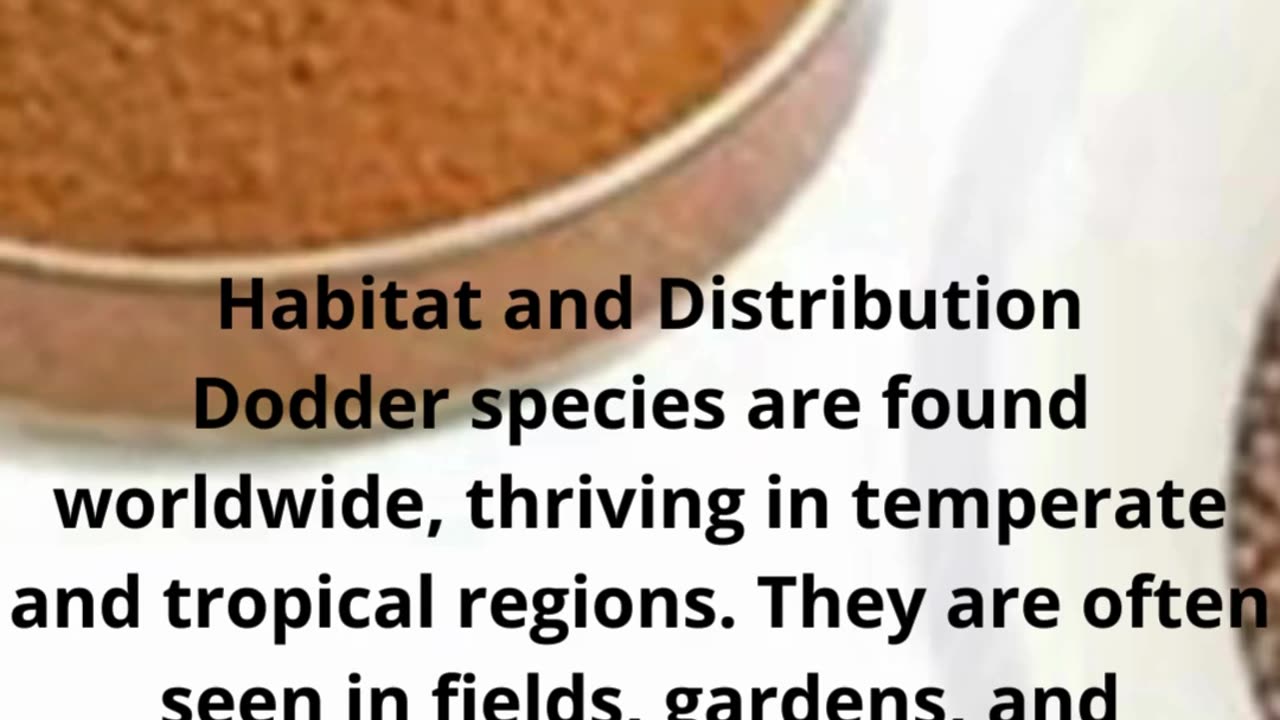Premium Only Content

Dodder Seed
Dodder Seed: A Comprehensive Overview
Botanical Profile
Dodder seed is derived from various species within the genus *Cuscuta*, a group of parasitic plants commonly referred to as dodder. These plants are known for their thread-like, twining stems and their ability to parasitize a wide range of host plants, extracting water and nutrients directly from them.
https://bit.ly/4a8YdR9
Physical Characteristics
The seeds of dodder are small, typically ranging in color from yellowish-brown to dark brown. They are hard and possess a rough, pitted surface which aids in their attachment and dispersal. Due to their resilient nature, dodder seeds can remain viable in the soil for several years, waiting for optimal conditions to germinate.
https://bit.ly/4a8YdR9
Habitat and Distribution
Dodder species are found worldwide, thriving in temperate and tropical regions. They are often seen in fields, gardens, and alongside roadsides, wherever suitable host plants are present. The seeds can spread through various means, including wind, water, and being inadvertently transported by animals or human activity.
https://bit.ly/4a8YdR9
Parasitic Nature
Dodder plants lack chlorophyll, making them unable to perform photosynthesis. Instead, they rely entirely on their host plants for sustenance. Upon germination, the young dodder seedling must quickly find a host; otherwise, it will perish. Once it attaches to a host, the dodder plant forms haustoria, specialized structures that penetrate the host's tissues and siphon off nutrients and water.
https://bit.ly/4a8YdR9
#### Medicinal Uses
Dodder seed has been utilized in traditional medicine, particularly in Chinese and Ayurvedic practices. It is believed to possess several health benefits, including:
- **Kidney Health:** Dodder seed is often used to support kidney function and treat related disorders.
- **Reproductive Health:** It is considered beneficial for enhancing fertility and treating sexual dysfunction in both men and women.
- **Liver Protection:** The seed is used for its hepatoprotective properties, helping to protect and detoxify the liver.
- **Vision Support:** Some traditional uses include improving eyesight and treating eye-related conditions.
https://bit.ly/4a8YdR9
Modern Research and Uses
Recent scientific studies have investigated dodder seed for its potential health benefits. Research has highlighted its antioxidant properties, possible anti-inflammatory effects, and its role in promoting overall wellness. However, comprehensive clinical trials are still needed to fully validate these traditional uses and understand the mechanisms behind them.
Caution and Toxicity
While dodder seed is used in traditional medicine, it's important to approach it with caution. The parasitic nature of the plant means it can sometimes accumulate harmful substances from its host. Therefore, sourcing from reputable suppliers and consulting healthcare professionals before use is crucial.
https://bit.ly/4a8YdR9
Conclusion
Dodder seed is a fascinating component of both botanical science and traditional medicine. Its unique parasitic lifestyle, combined with its potential health benefits, makes it a subject of interest for further research and application. However, due diligence and careful consideration are essential when incorporating dodder seed into health and wellness practices.
https://bit.ly/4a8YdR9
-
 8:38:13
8:38:13
Dr Disrespect
20 hours ago🔴LIVE - DR DISRESPECT - MARVEL RIVALS - I AM GROOT
327K64 -
 5:58:38
5:58:38
Fresh and Fit
12 hours agoResponding To Druski Skit, Tate Case Win, Fuentes Assassination Attempt & MORE
224K46 -
 4:13:32
4:13:32
Nerdrotic
16 hours ago $65.84 earnedSUPERMAN Drops, Disney Cuts WOKENESS? Hollywood DEI is DEAD | Friday Night Tights 333 Little Platoon
179K65 -
 1:23:14
1:23:14
Talk Nerdy 2 Us
13 hours agoSpecial Guest - Next UFC Superstar - Dani Aleksovska
87.9K -
 1:02:40
1:02:40
Man in America
14 hours agoThe Elites Are Losing Their War on Our Children w/ Robert Bortins
42.1K14 -
 3:30:43
3:30:43
I_Came_With_Fire_Podcast
17 hours agoGovt' Shutdowns, VA Scandals, MORE Drones, Syrian Strikes and staged rescues , and The DHS!
128K24 -
 56:55
56:55
The StoneZONE with Roger Stone
12 hours agoTrump Should Sue Billionaire Governor JB Pritzker for Calling Him a Rapist | The StoneZONE
96K11 -
 59:21
59:21
Adam Does Movies
12 hours ago $2.89 earnedMore Reboots + A Good Netflix Movie + Disney Live-Action Rant - LIVE
60.7K4 -
 36:28
36:28
TheTapeLibrary
21 hours ago $12.55 earnedThe Disturbing True Horror of the Hexham Heads
84.1K10 -
 6:08:00
6:08:00
JdaDelete
1 day ago $7.87 earnedHalo MCC with the Rumble Spartans 💥
61.8K8